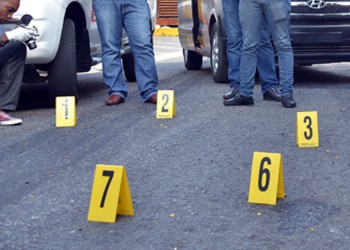A recent government announcement about an alleged drop in the homicide rate in Venezuela’s capital, Caracas, raises strong doubts about whether official figures are being utilized transparently and hides an increase in deaths at the hands of the police and army.
Interior Minister Néstor Reverol announced on October 11 that killings in Caracas had seen “a significant reduction of 35.4 percent” in 2017, without giving further details, reported El Universal.
Roberto Briceño León, a sociologist and director of the Venezuelan Violence Observatory (Observatorio Venezolano de Violencia – OVV), which tracks homicides across Venezuela, has identified several factors that cast doubt on the official facts. Caracas is also the deadliest capital in the world, according to a Mexican non-governmental organization, the Citizen’s Council for Public Security and Criminal Justice (Consejo Ciudadano para la Seguridad Pública, Justicia y Paz).
1. Police and Army Killing More People
The supposed reduction in homicides in Caracas, the second-most violent city in the world in 2017, is unlikely to be due to the implementation of a proper security policy, just as the country is undergoing a severe social and economic crisis.
“What has changed is how the killings are taking place,” Roberto Briceño León told InSight Crime. “While homicides might have dropped, fatal cases of resisting authority have increased in certain states.”
Briceño León warned that the data collected by the OVV shows an increase in cases of “resisting authority” (homicides carried out by police) and extrajudicial executions, although no complete figures are available. “There are areas where the police have killed more people than the actual criminals,” said the expert.
Data from the Victim’s Monitor (an observatory which maintains a registry of homicide victims entering morgues in Caracas) shows a similar pattern. From the observatory’s creation in May to December 2017, 374 cases of resisting authority were registered, accounting for 30 percent of the total homicides (1,242) registered in Caracas over the same period. In comparison, from January to September 2018, 481 cases of resisting authority were tracked, a 13 percent rise, which means the authorities are responsible for 43 percent of homicides in Caracas. And this number has risen still further to 57 percent in the last five months, according to Juan Mejía, one of the observatory’s coordinators. This confirms a dark truth: The police and the army are killing more people than the criminals are.
2. Untrustworthy Data
Since 2012, the Venezuelan government has not published official information about crimes in the country. Some data leaked from within the Interior Ministry shows that from January 1 to October 14, 2017, 982 homicides were registered in Caracas, compared with 635 for the same period in 2018. This drop is similar to the reduction announced by Reverol.
However, Briceño León warns that these numbers should be carefully reviewed.
“We treat this data with a lot of caution. For example, in Lara (a department in northwest Venezuela), our reports show more homicides than those in the ministry’s data. We do not trust this data, even though this is the official version we are being given,” the expert told InSight Crime.
3. Illusion of Migration
Mass migration from Venezuela has topped 2.3 million people, according to the International Organization for Migration. This huge drop out of a population of around 31 million may lead to a seeming drop in the homicide rate.
Since there is no precise data about the scale of this migration, it is possible that the alleged drop in homicides never took place. “It may be that the number of homicides has dropped, but not the homicide rate. Due to migration, homicides might be down but not the overall murder rate,” explained Briceño León.
According to the OVV, Caracas had a murder rate of 109 homicides per 100,000 people in 2017, far above the regional average of 21 homicides per 100,000. Venezuela had the highest homicide rate in the world in 2017.
4. More Morgues, More Victims
Since the second half of 2017, the government has opened four new morgues in hospitals across Caracas, with the stated objective of reducing the pressure on the Bello Monte morgue, which was the only forensic medical unit in the city.
However, this necessary step makes it difficult to precisely track homicides in the city. “We have noticed that there is an important under-reporting of homicides, as not all the killings are being registered,” said Briceño León.
SEE ALSO: InSight Crime’s 2017 Homicide Round-Up
Reporters are prevented from accessing these morgues and relatives of the victims are barred from speaking to the press.
5. Crime Moving to New Areas
The OVV director maintains that the explosion of crime in Venezuela has resulted in a voluntary curfew. In cities like Caracas, many people avoid being outside their homes after 6 p.m. due to fear of crime and the difficulty of moving around the city.
“This means that criminals are now targeting other places and opportunities,” explained Briceño León, adding that “in recent months, murders have taken place in places once thought unthinkable, such as beaches and amusement parks.”
The expert concluded that “while the government may claim the murder rate has fallen, the indicators we have for 2018 so far show that murders are not diminishing.”

